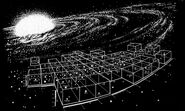The Vulcan system, also known as the 40 Eridani system or Omicron2 Eridani system, was an inhabited planetary system located in the Vulcan sector of the Alpha Quadrant.
This was a trinary star system. The primaryKeid (the proper name for 40 Eridani A) was an orange star and its companions 40 Eridani B and 40 Eridani C were a white dwarf star and a red dwarf star, respectively. Whereas Keid was the primary of a single star system, 40 Eridani B and C together formed a binary star system. (DIS: "Magic to Make the Sanest Man Go Mad"; PIC: "Maps and Legends"; SNW: "Charades")
Planetary system[]
In the 40 Eridani A system, the closest planet to the star was 40 Eridani A I. Next, there were the binary planetsT'Khut and Ni'Var. The latter was the homeworld of the Vulcans and the ancestors of the Romulans. Elsewhere in the system, there was the dwarf planetDelta Vega. On the outer reaches of the system, there was an asteroid belt that acted as a boundary between this system and 40 Eridani B/C.
The Kerkhovian homeworld Kerkhovorbited the star 40 Eridani C. (Star Trek; SNW: "Charades")
Vulcan system |
|---|
See also[]
History[]
In 2257, during the first Federation-Klingon War, this system was near the front line. (DIS: "The War Without, The War Within")
In 2258, in the alternate reality, Delta Vega was the location of a Starfleetoutpost. That year, Nero destroyed the planet Vulcan by creating a small black hole in its core. (Star Trek)
Stellar cartography[]
The Vulcan system was visible from Earth in the constellationEridanus. (DIS: "Magic to Make the Sanest Man Go Mad")
Neighboring the Andorian system, it was located approximately 16.34 light years (5 parsecs) from the Sol system. (ENT: "The Andorian Incident", "Home", "Daedalus"; DIS: "Magic to Make the Sanest Man Go Mad")
In the 2150s, this system's position was labeled on an United Earthstar chart which was displayed in several crew and guest quarters aboard the Enterprise. (Star Trek: Enterprise, set decoration))
In 2256, Vulcan was labeled on the star chart "Alpha/Beta Quadrant Overview" in the ready room aboard the USS Discovery. (DIS: "Magic to Make the Sanest Man Go Mad")
In 2258, the system's location was labeled on a star chart seen on the main viewscreen of the USS Enterprise. (DIS: "Such Sweet Sorrow, Part 2")
In 2259, the location of this system was labeled on a stellar cartography chart that was seen on the USS Enterprise's ready roomviewscreen. This system's symbol had a bluecolor, indicating it's affiliation with the Federation. (SNW: "Strange New Worlds", "Spock Amok", "A Quality of Mercy")
In 2293, the location of Vulcan in the Milky Way Galaxy was labeled in a star chart that was in CaptainJames T. Kirk's quarters aboard the USS Enterprise-A. (Star Trek VI: The Undiscovered Country, okudagram)
On stardate 1292.4, this system's position was labeled in a chart used during a Section 31Alpha Teambriefing. (Star Trek: Section 31)
In the 2360s, according to the dedication plaque for the USS Phoenix, the 40 Eridani system was located in the Sol sector. Within twenty years, there was a Vulcan sector shown on a star chart of sectors. This sector was presumably named after this system. (TNG: "The Wounded"; PRO: "Starstruck")
The system's location was labeled in a Federation star chart that was in Fleet AdmiralKirsten Clancy's office at Starfleet Headquarters in 2399 and on the bridge of the USS Titan-A in 2401. 40 Eridani was in or near to Federation space. (PIC: "Maps and Legends", "The Next Generation", "Disengage")
In 2401, this system's position was labeled on a star chart used by CaptainWilliam T. Riker during his attempt at finding the last known location of the SS Eleos XII. (PIC: "The Next Generation")
Appendices[]
Background information[]

T'Khut and its moon seen from the surface of Vulcan

Two other worlds in the Vulcan system seen from the surface of Vulcan
A picture of a star chart supposedly used for Star Trek: Discovery was tweeted by Ted Sullivan on November 28, 2017. According to this map, the star Vulcan was also known as 40 Eridani A. [1]
The original theatrical edit of Star Trek: The Motion Picture depicted four large orbs in the Vulcan sky. They were removed in the DVD release of Star Trek: The Motion Picture - The Director's Edition and replaced by an orange sky. According to Star Trek: Communicator issue 136, p. 27, the additional planets were removed for the reason that the scene took place during daytime, so a night sky was not appropriate, and they were elements that distracted the viewer from a scene intended to take place on a far-off monastic temple. Vulcan in and of itself was considered to be interesting enough without cluttering the sky with these planets.
In the Star Trek: Discovery episodes "Lethe", "If Memory Serves", and "Such Sweet Sorrow", celestial bodies were seen from the surface of Vulcan. For the first time, in "Unification III", celestial bodies near to Vulcan were seen in space.
There was further information on this system from the Star Trek: Star Charts, (pp. 18, 19, 36, 45, 58, and 60) and Stellar Cartography: The Starfleet Reference Library ("Stellar Cartography" pp. 14-15, 17, 22-24, 34, 36, and 46; "The Dominion War: Strategy and Battles, 2373-75"). The 40 Eridani (Omicron 2 Eridani) system had an orbital period of 248 years. This system was known to the Vulcans as Nevasi.
Two thousand years ago, the Vulcan system was a stop on the Debrune trade routes. On his final voyage, in 2120, Zefram Cochrane visited this system. In the 2150s this system was in the Earth Trading/Exploration Region, with it being a stop on the Earth trade routes. This system was threatened by the Dominion after they occupied Benzar in 2375.
There had been, however, no direct canonical reference of the Vulcan system being the 40 Eridani system before it was canonized in the Star Trek: Picard episode "Maps and Legends". Gene Roddenberry, James Blish and multiple other background sources were among the first to associate the Vulcan system with 40 Eridani. One of the earliest sources for this proposal was the 1980 reference work Star Trek Maps (pp. 25-26). An alternative possibility was proposed by theStar Trek Spaceflight Chronology (first published in 1979), which was that Epsilon Eridani could be the Vulcan system. Roddenberry favored 40 Eridani, due to the comparative ages of the two systems. In a letter printed in Sky and Telescope magazine in July 1991, Roddenberry wrote, "Based on the history of life on Earth, life on any planet around Epsilon Eridani would not have had time to evolve beyond the level of bacteria. On the other hand, an intelligent civilization could have evolved over the aeons on a planet circling 40 Eridani. So the latter is the more likely Vulcan sun." He also made the presumption that the planet orbited the primary star. [2] This association was picked up by the books The Worlds of the Federation (p. 18) and Star Trek: Star Charts (p. 58). Both sources identified Vulcan as the second planet in the system, which Star Charts (pp. 19 & 45) located in Sector 005 in the Beta Quadrant.
In "Home" and "Daedalus", Vulcan was mentioned as being slightly over sixteen light years from Earth, the same distance between Earth and 40 Eridani A. According to text commentary by Michael and Denise Okuda for "The Forge" on the ENT Season 4 DVD, the possibility of Vulcan being located in the 40 Eridani system originated from a suggestion by novelist James Blish. When three astronomers (Sallie Baliunas, Robert Donahue, and George Nassiopoulas) who had been studying the system at Mount Wilson Observatory published a letter stating that the star "40 Eridani A could support a planet with Earth-like life" and that it would "have the Sun's brightness for a planet fifty million miles away", they theorized that Vulcan could be in orbit of this star, a theory Gene Roddenberry himself supported by signing their letter, according to Sky & Telescope, 1991 July.
In a tweet from Star Trek: Strange New Worlds first assistant art director Timothy Peel, there was an image of the Vulcan system, which according to him was seen at the console holding the astrogator of the USS Enterprise. The system was depicted as a three-planet system, containing the planets 40 Eridani A 1, T'Khut, and Vulcan. The latter two planets were in a co-orbital relationship. T'Khut was orbited by an unnamed moon. Past Vulcan and T'Khut, there was an asteroid belt. Lying nearby, there were the stars 40 Eridani B and 40 Eridani C, which, too, had a co-orbital relationship. Delta Vega was not included on the chart. [3]
The star chart seen in the series Star Trek: Enterprise made its first appearance in CrewmanDaniels quarters in "Cold Front". It was also seen in several other episodes of the series, from 2151 to 2154. (For more information, see Federation star charts#United Earth Alpha/Beta star chart)
Apocrypha[]
Non-canon sources, such as the novel Spock's World and the reference book Spaceflight Chronology, mention there being up to 7 planets in orbit of Vulcan's sun.
In Last Unicorn Games' Star Trek Roleplaying Game sourcebooks Planets of the UFP and The Way of Kolinahr, 40 Eridani A was orbited by six planets, known as Ket-Cheleb, Vulcan, Valdena, Tel-Alep, Kal-Apton, and Kir Alep.
In the video games Star Trek: Fleet Command and Star Trek: Infinite, the fourth planet in orbit of 40 Eridani A was Delta Vega. Both games also named the first planet "Ket-Cheleb", as in the Last Unicorn Games role-playing game. Infinite also shows at least two planets in orbit of 40 Eridani C.
External links[]
- 40 Eridani at Memory Beta, the wiki for licensed Star Trek works
- 40 Eridani at Wikipedia
- 40 Eridani at the Internet Stellar Database







